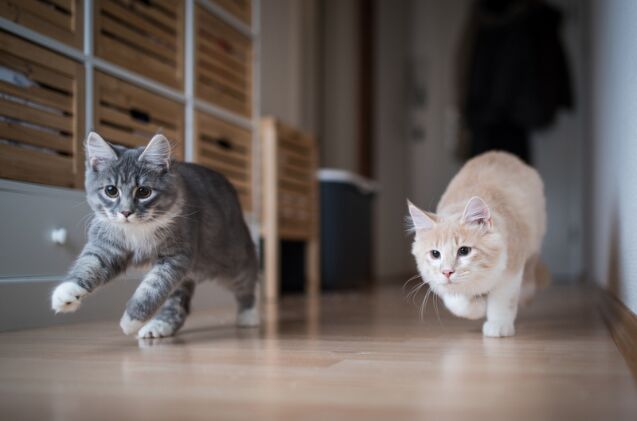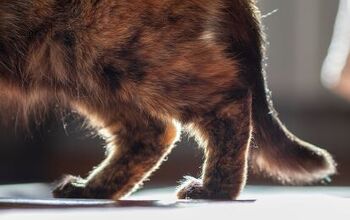How Much Exercise Does My Cat Need?

Cats are often known for their laidback and aloof personalities, lounging around the house like true couch potatoes. But just like us, our kitties need regular exercise to live a happy, healthy, and fulfilling life. That’s where your job as a cat parent comes in!
In this article, we will explore the importance of exercise for your cat, including how much exercise they need, the benefits of being active, and fun ways to include more physical activity in your cat’s daily routine. Whether you have an energetic young kitten or a calm senior cat, understanding their exercise needs can make a significant difference in their overall well-being.
How Much Playtime Does an Indoor Cat Need?
When choosing the perfect pet for your family, you have likely heard about how laid back and easy to care for cats can be. After all, they just lounge around the house all day. Right? The truth is that your cat needs daily activity to stay healthy and in shape.
The exact amount of exercise your cat needs will depend on several factors, including their age, breed, lifestyle, and individual health needs. For example, a cat that is obese and needs to lose weight to improve their health may need more physical activity than a cat that is already of a healthy weight.
That being said, the general rule of thumb is that a healthy adult cat should be engaging in 30 to 60 minutes of active playtime every day, split into shorter 10 or 15-minute play sessions.
If you are unsure about your cat’s specific needs, contact your veterinarian. They will be able to provide insight into how exercise and playtime can improve or help to maintain your cat’s quality of life at this stage and as they continue to age.
How Do I Know My Cat is Getting Enough Exercise?
There are several behavioral signs that a cat isn’t getting enough exercise that you can watch out for. Cats that don’t engage in regular physical activity often suffer from boredom, depression, or anxiety. While our cats obviously can’t speak to tell us this, we can pay attention to their body language and behavior to catch any signs of trouble.
Some key signs to watch out for include:
- Destructive Behavior: One of the first signs people notice when a cat is bored is that they start to exhibit bad habits and destructive behavior. This could include scratching your furniture, tearing apart the toilet paper, ripping curtains or screens, or stealing items they know they shouldn’t. It’s like a young child. They are bored and looking for ways to keep themselves entertained.
- Excessive Vocalization: Do you have a naturally vocal cat? If so, they may be trying to tell you that something’s wrong verbally. Some cats, when bored, will cry out for attention. This is a behavior we see in our two every time their morning playtime is even 5 minutes late.
- Change of Appetite: If they are feeling anxious or highly stressed, some cats will stop eating. Others, like humans, will turn to food during times of boredom. Any unexplained changes to your cat’s diet should be considered a sign of trouble – whether it’s a need for more exercise or something health-related.
- Over-Grooming: Cats are masters of self-grooming, but if a cat is stressed, anxious, or bored, they may take their grooming too far. This can often lead to the development of bald patches or skin irritation.
- Aggression or Irritation: Some cats become irritable or upset when experiencing stress and anxiety. This could result in uncharacteristic biting or scratching directed towards you, other family members, or other pets in the home.
- Loss of Energy or Lethargy: This may come as a surprise as most people will associate not enough exercise with having pent-up energy just begging to come out. However, a cat that isn’t getting enough physical activity can become depressed, which may present as being lazy, uninterested, or more aloof than usual.
Another important sign to watch out for is unexplained weight gain. Just as humans will gain weight if they aren’t getting enough exercise, so will your cat. Sure, they likely aren’t concerned with “how they look” each morning – but obesity is a growing problem in the United States and can introduce serious health consequences!
What Happens if You Don’t Exercise Your Cat?
There are some serious consequences that your cat could face if they aren’t getting enough physical activity in their daily routine. Exercise is an essential part of a healthy lifestyle. Here are a few possible health problems that your cat may face over time if they aren’t encouraged to be active enough:
Diabetes
One common complication that is associated with obesity in our cats is the development of feline diabetes. This occurs when your cat’s body is no longer able to produce or use insulin effectively to maintain a healthy blood sugar level. While it can be maintained, diabetes also increases your cat’s risk of other health complications, including hypoglycemia (low blood sugar), hyperglycemia (high blood sugar), renal disease, neuropathy, and cataracts.
Urinary Tract Diseases
Overweight cats are at higher risk of developing urinary tract diseases like urinary tract infections and bladder stones. While these conditions have a good prognosis when addressed appropriately, they can be incredibly uncomfortable throughout the treatment process.
Arthritis and Other Joint-Related Problems
Carrying around extra weight can put unnecessary stress on your cat’s joints. This is further complicated by the fact that an inactive cat isn’t building and maintaining the muscles around the joints that work to support and facilitate movement. The result is often the development or worsening of joint-related issues like arthritis and hip dysplasia.
Fatty Liver Disease
Your cat’s body will become used to receiving a certain amount of food daily. When that food is cut back, their body will start to use the fat stores for energy. This is an essential part of the weight loss process, but it can also put them at risk of developing fatty liver disease. As the amount of fat your cat’s body processes increases, the liver cannot keep up. The fat is then stored in and around the liver, negatively impacting liver function.
Can You Over-Exercise a Cat?
Yes, it is possible to over-exercise a cat. This usually occurs when you are trying to increase the activity levels of a previously inactive cat but moving too quickly or if you are exercising in warm temperatures. Both exhaustion and overheating can lead to severe health problems, so learning to recognize the signs is essential.
The warning signs of overheating and exhaustion in cats include:
- Panting or labored breathing
- Excess drooling
- Vomiting
- Diarrhea
- Pale or overly red Gums
- Rapid heart rate
- Trembling, shaking, or shivering
- Confusion or disorientation
- Weakness or collapse
The healthy body temperature of a cat is approximately 100.5 to 102.5 degrees Fahrenheit. If your cat’s body temperature exceeds that, it is another clear sign that they are overheating, and you need to act quickly.
If you notice any of these signs of exhaustion or overheating, contact your veterinarian. In cases where the over-exertion has been caught early, you may be advised to keep an eye on your cat while they rest or give tips for helping them feel better at home. However, in the most severe cases, this can be fatal. It’s better to be safe than sorry and trust the guidance of a professional.
5 Ways to Help Your Cat Get More Exercise
Make Playtime a Bonding Opportunity
Taking time out of your day each day to play with your cat is an amazing way to encourage them to be active while also building upon your relationship. The key to success is finding what style of play you and your cat each enjoy. In our house, this usually involves using a wand toy like the Go-Cat Da Bee Cat Wand Toy. This toy can be used to run our cats through the house from room to room, over their cat shelving, and more.
Get the Whole Family Involved
You may already share responsibilities like feeding your cat or cleaning the litterbox. But this isn’t the only way your partner or children can help with your cat’s care. After all, you aren’t the only one who has a bond with your cat, and you’re not the only one they want to spend time with.
With children, this will involve taking the time to teach them how to play with your cat correctly. Show them how to use the wand toy and explain that cats don’t necessarily want to roughhouse or be handled during playtime. You can let them choose the toy clipped to the end of the wand to get them more involved (there are many different options available).
This is also a great way to work with busy schedules. Consider scheduling playtime like an appointment, allowing each family member to commit to a time block.
Introduce a Cat Wheel
If you have a cat that wants to run, but you are limited on space, a cat exercise wheel like the LiiZee Cat Exercise Wheel for Indoor Cats may be the perfect solution. These wheels work similarly to a treadmill, allowing your cat to run long distances while still in one place.
When shopping for your exercise wheel, consider both the size you have available and the size of your cat. If a cat is too large for the wheel, it will cause their back to arch and bend in a way that could cause injuries. Your cat exercise wheel should be large enough that they can stand in it with their back nearly straight.
Offer Scratch Posts and Cat Shelving
Cat scratch posts, cat shelving, and other cat-focused furniture will create an environment that encourages your cat to be active by offering places to explore, climb, and play.
You can customize your space with different features or work around the limitations of the area you are working with. For example, our living room is set up with cat shelving up and around the couch at one end where space permits, while a single shelf leads around the corner to the loft stairs for the rest of their toys.
Take Note of Your Cat’s Favorites
Does your cat have favorite toys that they are always drawn to? Pay attention to which toys get them the most excited, encouraging them to play more, and leverage that. If your cat loves catnip-filled mice, ensure there are always a couple available when they feel playful. Does your cat prefer interactive toys that move and draw their attention? There are many great options, like our cat Pippen’s favorite, the PetSafe Peek-A-Bird.
Final Thoughts – The Importance of Exercise for Your Cat
Daily physical activity is needed for your cat to live a happy, healthy life. While most cats will happily engage in exercise on their own when given the right opportunities, the best way to ensure your cat is receiving the right level of physical and mental stimulation each day is to plan for play sessions. This is also an excellent opportunity to strengthen your bond and build upon your relationship.
If you are unsure of how much exercise your cat needs each day, talk to your veterinarian. You can also watch for signs your cat isn’t getting enough activity, such as destructive behavior, excessive vocalization, change in appetite, over-grooming, sudden aggression, lethargy, or weight gain. By recognizing these signs early, you can make changes to safely increase your cat’s exercise levels and prevent potential health complications.

Britt Kascjak is a proud pet mom, sharing her heart (and her home) with her “pack” which includes her husband John, their 2 dogs – Indiana and Lucifer – and their 2 cats – Pippen and Jinx. She has been active in the animal rescue community for over 15 years, volunteering, fostering and advocating for organizations across Canada and the US. In her free time, she enjoys traveling around the country camping, hiking, and canoeing with her pets.
More by Britt
























